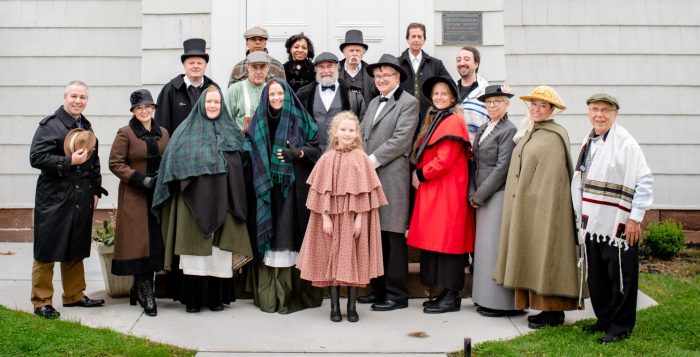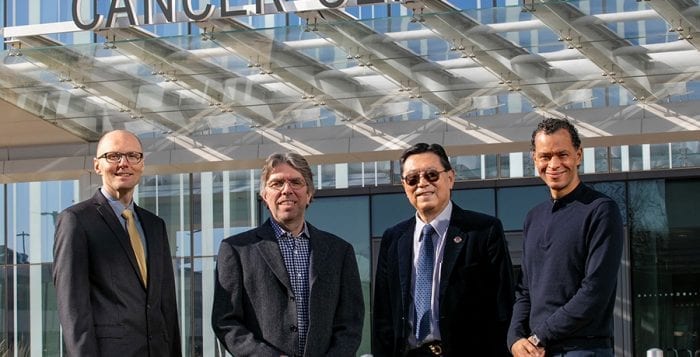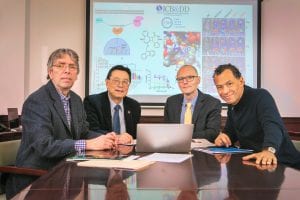By Kimberly Phyfe
On Saturday, October 21st, the Three Village Historical Society (TVHS) welcomed over 300 guests through their annual graveyard walk, the Spirits Tour, made possible through the help of 50 volunteers and staff.
Visitors met spirits from the Chicken Hill neighborhood in Setauket throughout the 100 years people lived there, between 1860 and 1960.
Chicken Hill was a one mile neighborhood located along Route 25A, where Stop & Shop is now, originally made up of Eastern European immigrants, Native Americans, and African Americans.
Today, the community of Chicken Hill is far from its original housing and cultural form. The people who lived there have lost their personal, cultural and social past. At present, they risk losing even that important and precious heritage: the memory and collective history of Chicken Hill.
This 29th Annual Spirits Tour was an effort to preserve that memory and to establish Chicken Hill’s place in the evolution of the Three Village Area.
The tour began at the Setauket Presbyterian Church at dusk and continued into the clear, moonlit night. Inside the fellowship hall were cider & donuts, a pop-up gift shop, and live music from the wonderfully talented Long Island Youth Development Inc.
Scott Ferrara, Exhibits & Collections Coordinator at TVHS, assembled an incredible mobile display of artifacts from the award-winning Chicken Hill exhibit. Scott printed dozens of historical images and brought out treasured items from the archives such as the Ridgway Family Bible.
Beverly and Barbara Tyler were on hand to speak about the Day Book on exhibit from the Tyler Brothers General Store circa 1908, mentioned by the first spirit Jacob Hart, portrayed by Wayne Hart. Both Beverly and Wayne shared about their family’s history in Chicken Hill with deep affection, and a desire for future preservation.
Nancy Scuri was a tour guide and remarked that “Having the family members tell their ancestors’ stories was an incredibly special touch. The group I led was interested and listening to all the actors, but when I told them they were watching direct descendants of the people they were portraying, it was all the more meaningful!”
Owen Murphy, a recipient of the Three Village Young Historian Award, also volunteered as a tour guide this year. “The fact that all the spirits were from the same place was amazing, as you were able to peer into the life of ordinary people in the 100 years of Chicken Hill’s existence,” he said.
There were four stops throughout the graveyard at Setauket Presbyterian, two more at the Village Green, and the last four were at Caroline Episcopal Church.
TVHS told humorous, honest, and heart-breaking stories of the actual people who lived, worked, and died here. Scripts were originally written by the TVHS Education Committee comprised of Donna Smith, Bev Tyler, Brian Bennett, Town of Brookhaven Historian Barbara Russell & Education Coordinator Lindsey Steward-Goldberg.
They then went on to be edited by Development Coordinator Kimberly Phyfe and volunteer / spirit Stephanie Sakson.
George Fear portrayed Charles, a spirit tending to the fenced-in Searing plot in the far corner of Caroline Church. “I’d heard about Chicken Hill but hadn’t had an appreciation for the richness of its history in Three Village until being exposed to it this year. It’s not a time in history which is documented or discussed nearly to the extent of others in the Three Village area (i.e. George Washington and the Culper Spy Ring) but so relevant and relatable given the ties so many families have to Chicken Hill and its history.”
TVHS Director Mari Irizarry says that plans for the 30th Annual Spirits Tour are already in the works. “We have so many ideas inspired by the Three Village area, our actors and guides, and local lore. Bringing history to life for our community is an incredible honor and one that I am proud to share in year after year. It is no exaggeration to say that this was our best Spirits Tour to date!”
So what keeps family, friends, and neighbors coming back for more? George Fear says that “I have always loved history, there’s an abundance of it in Three Village, and you learn something new and interesting every year. Most importantly, it’s the opportunity to meet and collaborate with a terrific group of people who are passionate and enthusiastic about history and make it an absolute pleasure to volunteer. What could be better than that? Needless to say, count me in as a spirit for next year and I am looking forward to the 30th Spirits Tour!”
Special thanks to Setauket Presbyterian Church, Caroline Episcopal Church, and the sponsors of the 29th Annual Spirits Tour: Annmarie’s Farm Stand, Luigi’s Pizzeria, Starbucks, Stop & Shop, and Town of Brookhaven Councilmember Jonathan Kornreich.
Author Kimberly Phyfe is the Development Coordinator for the Three Village Historical Society in Setauket.







